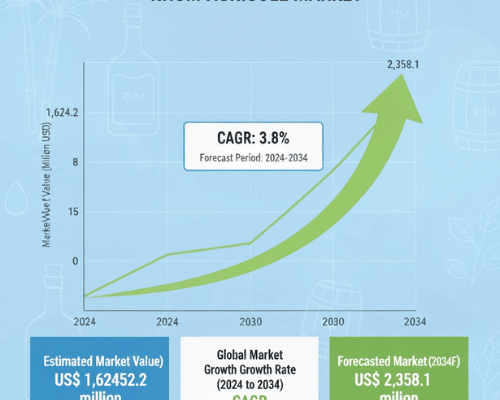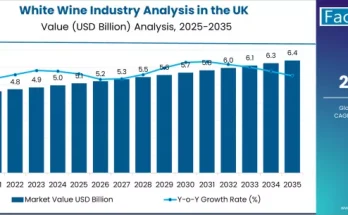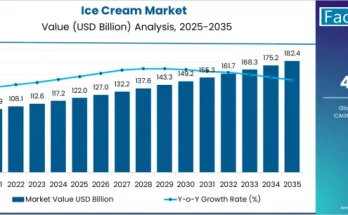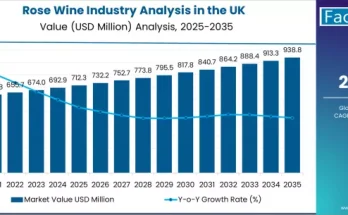The global rhum agricole market is charting a strong growth trajectory, fueled by rising global appreciation for authentic, terroir-driven spirits and the growing premiumization trend in the rum category. According to a recent report by Fact.MR, the market is expected to increase from US$ 1,624.2 million in 2024 to US$ 2,358.1 million by 2034, registering a steady CAGR of 3.8% over the forecast period.
Unlike traditional molasses-based rum, rhum agricole is distilled directly from fresh sugarcane juice, giving it a distinctive character that reflects its geographic origin and artisanal production process. With increasing consumer demand for authentic, handcrafted, and region-specific spirits, rhum agricole is securing its position as a premium segment within the global rum industry.
Strategic Market Drivers
- Rising Premiumization and Craft Spirit Movement
The growing global shift toward premium and ultra-premium spirits has significantly benefited rhum agricole producers. Consumers are increasingly drawn to unique, small-batch products that emphasize provenance and craftsmanship. Artisanal producers from Martinique, Guadeloupe, and Mauritius are leveraging centuries-old distillation techniques, gaining recognition in global markets for their authenticity and quality.
- Heritage and Geographic Indications (GI) as Market Catalysts
The Appellation d’Origine Contrôlée (AOC) designation for Martinique’s rhum agricole plays a crucial role in reinforcing authenticity and quality assurance. This certification ensures traditional production methods and regional identity, adding immense value in export markets where consumers associate AOC labeling with superior craftsmanship and heritage.
- Growing Global Appreciation for Rum Diversity
In mature markets such as Europe and North America, consumers are exploring new rum categories beyond the conventional molasses-based variants. Rhum agricole’s unique vegetal and aromatic flavor profiles appeal to connoisseurs and mixologists seeking differentiation in premium cocktails. This growing appreciation for category diversity is expanding rhum agricole’s footprint in high-end bars and retail outlets.
- Sustainable and Ethical Production Practices
Environmental sustainability is emerging as a defining theme across the beverage alcohol industry. Many rhum agricole distilleries employ eco-friendly methods, including closed-loop water systems, energy-efficient distillation, and organic farming practices. These efforts resonate strongly with eco-conscious consumers, further enhancing brand value and differentiation.
Regional Growth Highlights
Caribbean: The Epicenter of Authenticity
Martinique and Guadeloupe remain the heartlands of rhum agricole production, together accounting for the majority of global supply. The region’s volcanic soil, tropical climate, and deeply rooted distilling heritage provide unparalleled quality and consistency. With growing tourism and export demand, local producers are expanding capacity while preserving traditional methods.
Europe: The Largest Consumer Market
Europe continues to lead global consumption, particularly in France, the United Kingdom, and Germany, where rhum agricole enjoys strong distribution networks and loyal consumer bases. Premium spirit retailers and cocktail bars are driving awareness, while e-commerce channels have opened new growth avenues for niche brands.
North America: Emerging Premium Market
In the United States and Canada, rising interest in artisanal and heritage spirits is propelling rhum agricole into the mainstream. The market is seeing a surge in tasting events, mixology trends, and collaborations between Caribbean distilleries and U.S. distributors aimed at expanding product availability.
Asia-Pacific and Latin America: New Frontiers for Expansion
Growing disposable incomes and evolving consumer preferences in Japan, Singapore, and Brazil are creating fresh opportunities for rhum agricole brands. The appeal of exotic, high-quality spirits and expanding duty-free retail networks are expected to bolster sales in these regions over the next decade.
Market Segmentation Insights
By Type
- White Rhum Agricole: Known for its vibrant, grassy notes and used widely in cocktails.
- Aged Rhum Agricole (Vieux): Aged in oak barrels, offering complex aromas and smooth finishes, driving premium segment growth.
By Distribution Channel
- On-trade (Hotels, Bars, Restaurants): Dominates the segment with growing popularity among mixologists and cocktail lounges.
- Off-trade (Retail & E-commerce): Rapidly expanding through premium liquor stores and online platforms offering direct-to-consumer models.
By Price Range
- Premium and Super-Premium Segments: Expected to exhibit the highest CAGR, driven by luxury positioning and gift appeal.
Challenges and Market Considerations
Despite positive prospects, the rhum agricole market faces several challenges:
- Limited Production Capacity: Small-scale artisanal distilleries face scalability constraints.
- High Import Duties: Export growth is sometimes restricted by complex trade regulations.
- Consumer Awareness Gap: Outside the Caribbean and France, general awareness of rhum agricole remains limited.
Nevertheless, increasing marketing efforts, global spirits competitions, and digital storytelling are bridging these gaps, positioning rhum agricole as a luxury spirit with deep-rooted authenticity.
Competitive Landscape
The competitive landscape of the rhum agricole market showcases a dynamic interplay of tradition, innovation, and regional heritage. Key producers from the French Caribbean dominate the global scene, leveraging authenticity, AOC certification, and craftsmanship to command premium pricing.
Key Companies Profiled:
Distillerie Saint-James, Distillerie Damoiseau, Distillerie Neisson, Rhumerie de Chamarel, Rhum Bielle, Distillerie Depaz, Distillerie J.M., La Favorite Distillery, Rhum Clément, and Rhum HSE Habitation St-Etienne.
Artisanal craftsmanship remains a focal point, with brands emphasizing meticulous production methods and diverse expressions—from white agricole to aged rhums—to cater to a discerning global audience. The competition intensifies as producers introduce limited editions, innovative packaging, and storytelling that celebrates cultural heritage and terroir.
Future Outlook: Tradition Meets Global Modernization
The coming decade is expected to be transformative for the rhum agricole market, as global consumers continue to embrace authenticity, sustainability, and premium craftsmanship in their spirit choices. Producers who successfully blend heritage with innovation, ensuring consistency, eco-conscious production, and global branding, will be best positioned for sustained success.
With its deep cultural roots and growing global appeal, rhum agricole stands poised to redefine the premium rum segment—bridging the gap between tradition and modern luxury.



